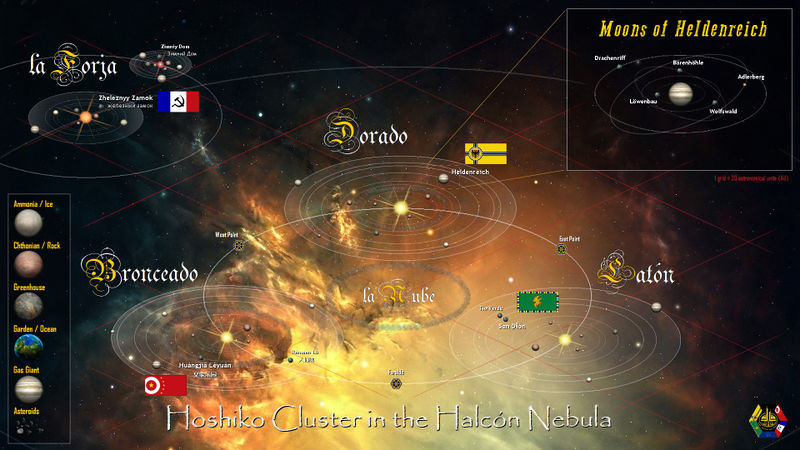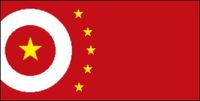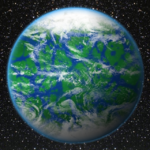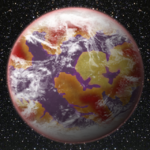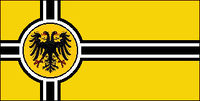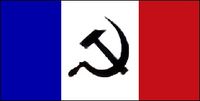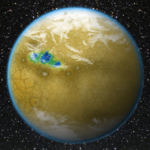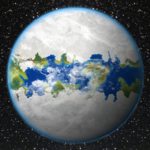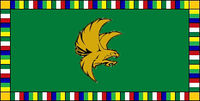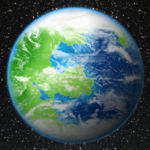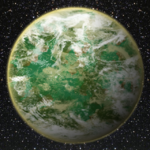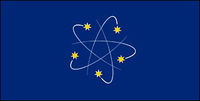Hoshiko Cluster
Main: Farside Station
NGC-8481, commonly referred to as the Hoshiko Cluster (after discoverer Komori Hoshiko, c. 2082), is an embedded micro star cluster comprised of five gravitationally bound companion stars located within the Halcón Nebula, 32 light-years (2,023,711 AU) from Earth. All the stars of the cluster have numerous planets, moons and some asteroid belts. The gas giant planets also have numerous moons, many of which are planet sized.
History
The Great Expanse
Following the successful live tests of the first functional reactionless drive engine--developed by Gail Hywel in 2071, the “Hywel Engine”--there quickly evolved a global competition between the most elite nations of Earth to become the first to colonize a new world. This was a period of history referred to as the Great Expanse.
Echoing back to the age of the Cold War Space Race of the 1950-70’s, each competing nation grew ever more ruthless and determined to win, regardless of the costs, means or methods. There arose a new age of nationalism, fanned to a high flame by extensive propaganda programs initiated by the various governments. Espionage of space technology, sabotage of foreign space production, kidnapping of key scientists and technicians, hoarding of critical resources, purchasing second-hand components, etc. all became common practices.
By the close of decade, there were seven primary contestants in the 2080 Space Race (ranked):
- United States of American (USA)
- People’s Republic of China (PRC)
- European Union (EU)
- Latino Consortium (LC) - Brazil, Mexico and several other Central American countries.
- Federation of Slavic Nations (FSN)
- Arabian Union (AU)
- Republic of India (RI)
On March 10th, 2086, the USA succeeded in becoming the first nation to construct an exploration & colonization ship. On June 3rd, 2086, the ship christened the Sam Walton, launched on an 11.8-light-year journey to the Tau Ceti system (thought to be the closest best opportunity of finding a habitable planet).
Then, just four months later, on October 12th, 2086, a Japanese astronomer named Komori Hoshiko discovered a cluster of stars in the Halcón Nebula. Using the most advanced astronomical scanning tech, other scientists were quickly able to identify a large quantity of Earth-like planets in the cluster. Practically overnight, the Hoshiko Cluster became the prime target for exploration and colonization.
Over the next fifteen month, all the other nations succeeded in completing and launching their ships, each pointed toward the Hoshiko Cluster, approximately 32 light-years (2,023,711 AU) from Earth.
The Latino Consortium ship La Santa María departed Earth on January 7th, 2087 and on December 23rd, 2124, was the first to reach the Hoshiko Cluster. During the greatest Christmas Eve celebration of the 22nd century, the captain of the ship proclaimed: “¡Bienvenidos al nuevo mundo!” - welcome to the new world. As the first to arrive, the LC had first claim to the new worlds and ultimately decided on the binary worlds of San Dión and Tío Verde in the Latón system.
Next to arrive was the European Union ship Brave Venture. The primary union states involved with the project (British, French, German, Irish, and Italian) each had a 20% allotment for crew and cargo space aboard the ship. In the final months leading up to their departure from Earth, tensions between the union states rose to the highest levels since the days of World War II. Days before the collapse of the EU and the onset of a Western European war, the German faction aboard the Brave Venture staged a coup to seize control of the ship and authority over other factions. When the shipped arrived in the Hoshiko Cluster, the Germans set their sights on the Dorado system and claimed for themselves four earth-like planet-sized moons in orbit around the large gas giant planet they named Heldenreich. The initial colony was established on the planet they named Löwenbau.
The People’s Republic of China ship Xīng wángcháo was the third ship to reach the Hoshiko Cluster. They established their colony in the Bronceado system, on the world of Rénmen Lù. A small percentage of the ships crew was comprised of Japanese and Korean scientists and technicians.
The next ship to arrive in the cluster was the Niemat Allah of the Arabian Union. However, their arrival was anything but victorious with it's arrival. Their transit had been plagued by numerous technical malfunctions and breakdowns. One final malfunction resulted in the ship crash-landing on the desert world they targeted in the La Forja system. Very few of the crew survived and ultimately were incorporated as a minority group into the Slavic Federation.
Last to successfully arrive was the Federation of Slavic Nations ship Zavoyevaniye. They arrived at the same desert world as the Arabian Union, which the Slavs named Zheleznyy Zamok. They laid claim to the La Forja and El Ascua systems.
The Republic of India ship Aastha aur ek Praarthana आस्था और एक प्रार्थना (“Faith and a Prayer”), got lost in transit, likely destroyed, and was never heard from again following their last report just 3 years 7 months into their journey from Earth.
Colonization & Territory Wars
The first hundred years following the initial arrival of the colonization ships to the Hoshiko Cluster was a time of frenzied construction and relative peace, as each colony struggled to establish and expand upon the tentative foundations laid on arrival. For the most part, each colony was as isolated from each other as they were from the homeworld of Earth. Space travel, and trade, was none existent, even within the near-earth-orbits of the colony worlds. The populations, economy and industrial capabilities of the colonies had to grow to a significant level to support space flight. Initially, there wasn’t even the need, due to the overabundance of unclaimed land and resources on the new worlds.
However, by the year 2251, a new phase in interstellar expansion within the Hoshiko Cluster began as the first space ships were constructed and placed into service. Although the capital worlds were still sparsely populated, there grew an urgency by the separate nations to expand outward and claim new worlds for future growth, especially to insure they made their claim before any of the others. In 2266, the colony established on Tío Verde in the Latón system was the first to be established beyond the capital worlds, followed closely by Bärenhöhle in the Dorado system in 2282.
Not until the Holtzmann Naval Expedition of 2587, did any of the nations send ships beyond the borders of their own star system to begin exploring and claiming territory. Historically, the Germans were the most aggressive and expansionist explorers of the 26th century. By 2595 and 2599, the freeports of West Point Station and East Point Station were constructed at the halfway points between the Bronceado and Latón systems, officially establishing the primary trade routes.
During this time of expansion, there were minor conflict, but the first official battle of territory wars didn’t occur until March 21st, 2604, when the Germans attempted to establish a claim to the planet of Atontado in the Latón system. Latonnia contested that they had already laid claim to this world and they denounced the Germans for even attempting such a claim in the Latón system. The Armada Espacial engaged the German exploration ship, destroying the ship and everyone aboard.
From 2604 onward, numerous territorial battles have occurred throughout the Hoshiko Cluster. By far, the Germans have continued to be the most aggressive and has maintained an attitude of superiority over the other five nations.
Hoshiko Cluster Systems
La Nube (“The Cloud”), located at the center of the cluster, is a thickening of the nebula (dust, gases, ice and small rocks) forming a dense cloud (micro nebula) approximately 12.3508 AU in diameter. Travel within this region is especially hazardous due to the limited range of visibiliy and extreme interference of comms and scanners. Although some exploration has been made of the outermost edges, none who have travelled deep within the cloud have ever returned.
El Cinturón de la Nube is an asteroid belt which rings La Nube at 9.2631 AU. The belt is very large and dense, measuring nearly 1 AU in width/height. The highly valuable resources of this belt have drawn numerous independent, or small business, mining companies hoping to find their fortunes. The numerous miners have drawn numerous bandits hoping to take their fortunes.
Core Systems the three primary stars of the cluster (Bronceado, Dorado and Latón) have aligned into a triangle (L-points) centered around La Nube, orbiting at about 24.5 AU.
Core Stations: located at the complimentary L-points (60-degrees along the orbital paths of the three core systems) are three large space stations, constructed and controlled by the Hishiko International Space Commission (HISC). Each station serves as a base of operations for local patrols, as well as a way-point and trade market for merchant traffic. The station clockwise of Dorado is known as East Point Station. The one counterclockwise is known as West Point Station. The third, on the opposite side of La Nube, is called Farside Station.
Fringe System: orbiting La Nube at a distance of 62.4481 AU, is the star La Forja and its small companion star El Ascua. The planets orbiting both these stars are collectively referred to as the La Forja system.
Bronceado
The Bronceado ("bronzen") system has a G2 V 'yellow' main-sequence star, nine planets and an asteroid belt. Of the nine planets, two are classified as habitable. During the Great Expanse, this system was claimed by those of the Chinese ship Xīng wángcháo ("Dynasty of the Stars"). The first colony was established on the planet of Rénmen Lù in 2128. In the year 2155, the military general Shen Yusheng organized and lead a revolt that overthrew the political element loyal to “old China”. Through force, he established himself as the first emperor of Rénmen Lù, founding the Shēn Dìguó ( 身帝國 , "Shen Empire"). Since then, rule of the government has been passed father-to-son. Although Rénmen Lù has remained the primary world of the Shen Empire, in the year ????, Emperor Shen Guoliang mandated that the second habitable planet of Bronceado be renamed to Huángjiā Lèyuán and designated the planet as a sanctuary where the only settlement would be the new imperial palace.
Government
Qiángdà de Shēn Dìguó 强大的身帝國 (“The Mighty Shen Empire”), is a government of Chinese descent fully independant of the “old China” of Earth.
Government Type: caste dictatorship
Capital: Jiang on Rénmen Lù
Ruler: Emperor Shēn Jun Zhìxin
Control Rating: repressive (5)
Territory: Bronceado system
Space Navy: the Héngxīng Haijūn ( 恆星海軍 ) is the third largest naval fleet of the Cluster, but have been limited to defensive operations within the territory inside (and including) the Bronceado asteroid belt.
Police Forces: the Héngxīng Jingchá ( 恆星警察 ) is the Chinese republic’s civil policing organization; moderate level of corruption.
Huángjiā Lèyuán 皇家乐园 (Royal Paradise)
Orbital Radius: 0.8728 AU
Gravity: 1.4 G
Atmosphere: 2.87 ATM (Very Dense) Nitrogen 78%, Oxygen 21%, Pollutants
Climate: 58 to 93ºF (Normal), average annual rainfall of 86.28”
Hydrographic Coverage: 82%, a “waterworld”
Geology/Geography: Shanghai is a “waterworld” with numerous island clusters and chains. All the land masses of this world were created as subaquatic volcanic formation. The planet has a heavy level of volcanism and a moderate level of tectonic activity. Quakes are common and very powerful, but only near plate boundaries. There are many regions with volcanoes or clusters of volcanoes. Like the Hawaiian islands, these islands quickly develop fertile landscape with lush vegetation and wildlife. These islands are covered in pools, rivers and waterfalls resulting from the extreme level of annual rainfall. Bamboo trees, introduced by the early colonists has been especially successful on this planet.
Native Wildlife: There are numerous aquatic species found on this planet, including several varieties of giant carnivorous fish and sea-reptiles. On the islands, insects, reptiles and birds are found in many varieties. No mammal have been discovered.
Rénmen Lù 人们陆 (the People's Land)
Orbital Radius: AU
Gravity: G
Atmosphere: ATM () Nitrogen 78%, Oxygen 21%, Pollutants
Climate: 58 to 93ºF (Normal), average annual rainfall of 86.28”
Hydrographic Coverage:
Geology/Geography:
Native Wildlife:
Population: 523,522,400 (11.5% cluster total)
Only a very small proportion of the population lives in remote locations; a majority live in one of the heavily built-up urban cities.
About 4% of the population is comprised of Japanese & Korean second-class citizens. The Japanese & Korean people are nearly a subjugated race, living with very few rights or privileges and very little income, with only one major exception. Japanese technology is by far the most advanced in the Cluster. The eldest son of each master technician is solely trained in these skills. These few are afforded a much higher level of income and status.
Dorado
The Dorado (“golden”) system has a G4 IV 'yellow subgiant' star, nine planets and an asteroid belt. The gas giant planet named Heldenreich has four habitable moons--Bärenhöhle, Drachenriff, Löwenbau & Wolfswald--which were colonized by the Europeans from the ship Brave Venture. The first colony was established on the planet of Löwenbau in 2127. During the journey from Earth, the former European Union government was overthrown by the German union state crew. They formed a new government, Das Falken Imperium (the Hawk Empire), with the people of Britain, France, Ireland and Italy subjugated by force to the new empire. Strict fertility laws enforced by the empire have greatly limited the population growth of the subjugated races, making them all a minority of the current empire.
There is a vast gulf separating the elite, high-class, nobility from the low-class, common peasantry of the empire. Where the nobility serves as military officers, merchants, scholars and scientists, the peasantry serves primarily as farmers, ranchers, servants, tradesmen and laborers. Most of the peasantry have struggling incomes and often live below average status. Revolts and rebellion are not uncommon, but seldom successful. The minority groups of the British, French, Irish and Italian predominately live at a poor income level and generally lack any access to educations, so most often work as laborers.
Government
Das Falken Imperium, the German led empire, is the controlling government of the Dorado system.
Government Type: dictatorship
Capital: Neu Heidleburg on Löwenbau
Ruler: Emperor Wolfhard Ramberg III
Control Rating: repressive (5)
Territory: Dorado system
Space Navy: the Kaisers Marine
Police Forces: the Sternjäger (star hunters)
Löwenbau
Orbital Radius: 0.0033 AU
Gravity: 1.37 G
Atmosphere: 0.52 ATM (Thin) Nitrogen 78%, Oxygen 21%
Climate: 58 to 93ºF (Normal), average annual rainfall of 28.64”
Hydrographic Coverage: 81% comprised primarily of two hemispheric oceans.
Geology/Geography: All the same types of geologies found on Earth are encounter here as well. The planet has a moderate level of volcanism and tectonic activity. Quakes are common and very powerful, but only near plate boundaries. Volcanoes are small and only occasionally active, located most near plate boundaries.
Native Wildlife: This planet has a very wide variety of insects, fish, mollusks, small reptiles, birds and small mammals, but lacks any large herbivores or carnivores.
La Forja
The La Forja (“The Forge”) system has a K0 V 'orange' star, seven planets and the companions star El Ascua (“The Ember”), which is a M2 V 'red dwarf' star with eight planets. There are two habitable planets, named Zheleznyy Zamok and Zimniy Dom. The colonial transport ship Zavoyevaniye завоевание (Conquest) arrived at the same desert world where the Arabian Union ship Niemat Allah نعمة من الله (“Grace of Allah”) crash-landed. There, the Slavs established the colony of Rukhnut on Zheleznyy Zamok.
Arabians still make up a very small percentage of the population, a minority of the Slavic federation.
Government
The Federatsiya Slavyanskikh Natsiy' Федерация славянских наций ("Federation of Slavic Nations")(FSN) is the controlling government of the La Forja and El Ascua star systems.
Government Type: Socialist Representative Democracy
Capital: Rukhnut (crash down) on Zheleznyy Zamok
Ruler: Prorektor Ranko Bozhilovich Milanovic (provost marshal)
Control Rating: controlled (4)
Territory: La Forja and El Ascua systems
Space Navy: Kosmos Flot
Police Forces: Molniyenosnyy Renegat (the lightning renegade)
Zheleznyy Zamok Железный замок (the Iron Castle)
Orbital Radius: 0.9089 AU
Gravity: 1.08 G
Atmosphere: 1.13 ATM (Standard) Nitrogen 78%, Oxygen 21%
Climate: 84 to 119ºF (Tropical), average annual rainfall of 3.93”
Hydrographic Coverage: 34% a single vast ocean basin and aquifers feeding sparsely scattered oasis.
Geology/Geography: Due to the low hydrographic coverage, tropical temperatures and minimal annual rainfall, the majority of the planet is comprised of a vast desert wilderness. A majority of the terrain is inland seas of sand (dunes) with isolated island mounds of hard-pack dirt, sandstone hills carved by crevices and gullies, or basalt mesas and mountain ranges. Quicksand pits are a hazard commonly found in lowland valleys. Much of the planet's water is located in giant deep subterranean aquifers which feed up to small oasis sparsely found in the deserts. The planet has a moderate level of volcanism and tectonic activity. Quakes are common and very powerful, but only near plate boundaries. Volcanoes are small and only occasionally active, located most near plate boundaries.
Native Wildlife: the most prolific life form on the planet are beetles, with thousands of species and a vast variety of shapes, sizes and colors. There are a couple of higher life forms as well, including a large variety of fish in the ocean, a dozen species of lizards, a small gazelle-like herd animal and a small, rarely seen, sand cat. All these species have adapted to survive in the extreme desert environment.
Zimniy Dom Зимний Дом (Winter Home)
Orbital Radius: 0.475 AU
Gravity: 0.79 G
Atmosphere: 0.59 ATM (Thin) Nitrogen 78%, Oxygen 21%
Climate: -1 to 34ºF (Cold), average annual rainfall of 15.61”
Hydrographic Coverage: 42%, glacial ice and a few small lakes and creeks in the tundra region.
Geology/Geography: Due to the cold temperatures, the majority of the planet falls within arctic and subarctic terrains. There is an equatorial belt of grassy tundra; the rest of the planet is covered in glacial ice and snow. The planet has a light level of volcanism and no tectonic activity. The world’s crust is very thick and immobile. Quakes are rare and weak. There are only a few areas of minor volcanic activity, but these have formed massive shield volcanoes (40,000 ft or higher). No other mountains.
Native Wildlife: Only found in the equatorial tundra region, there are a few life forms, including a variety of insects, small ground rodents, large herding herbivores, and a species of carnivorous canine.
Laton
The Latón (“brass”) system has a G0 V 'yellow' star and nine planets. The habitable, binary planets of San Dión and Tío Verde have been colonized by the Brazilian-Mexican people from the ship La Santa María.
Government
The La República Federal de Latónanos, aka. “Latónnia”, is the combined government of the worlds of San Dión and Tío Verde.
Government Type: oligarchy dictatorship
Capital: Galindo on San Dión
Ruler: el Consejo de Jefes (“Council of Chiefs”)
Control Rating: controlled (4)
Territory: Latón system
Space Navy: the “Armada Espacial”, is the second largest naval fleet in the Cluster, but to date, the fleet has only ever been tasked for the safeguard and defense of the Latón system. Most of their efforts are devoted to combating the criminal elements of the Baldío Cartel, Bandidos de la Nube, and Hessian Rogues.
Police Forces: the “Policía del Espacio” is the federal police force of the Latónnia worlds, tasked with patrolling local space transit lanes and orbital traffic. They are known to be especially strict, cruel, and corrupt, yet susceptible to bribes.
The political structure of Latónnia closely matches the power structure of the drug cartels who funded the Latino Consortium colony ship La Santa María, with the Jefes (“chiefs”) holding the highest ranking positions of power. There are currently a total of 17 Jefes serving on the governing council. These positions of rulership are not earned by vote, heirship, but either taken (coupe) or received (successorship) upon the death of a Jefe who rules for life. Internal power struggles and political corruption are major problem within the government.
Population: 1,035,477,400 (22.8% cluster total)
The people of Latónnia are primarily comprised of the Brazilian and Mexican colonial descendants; the small groups of other Central American citizens who were aboard the colony ship have long since been absorbed into the collective Latón culture. The pyramid-structure nature of the Latón government/society rank/status system means that a majority of the population have poor incomes and a lower than average status. These lowest ranking are “preyed upon” by the next higher level, which in turn is “preyed upon” by the next higher level, etc.
Officers in the Armada Espacial are ranked pretty high in the social structure.
San Dión (Saint Dion)
Orbital Radius: 3.4858 AU
Gravity: 1.16 G
Atmosphere: 1.13 ATM (Standard) Nitrogen 78%, Oxygen 21%
Climate: 53 to 88ºF (Normal), average annual rainfall of 25.35”
Hydrographic Coverage: 76%, an Earth-like distribution of oceans and continents.
Geology/Geography: All the same types of geologies found on Earth are encounter here as well. The planet has a moderate level of volcanism and tectonic activity. Quakes are common and very powerful, but only near plate boundaries. Volcanoes are small and only occasionally active, located most near plate boundaries.
Native Wildlife: This planet has a very wide variety of insects, fish, mollusks, small reptiles, birds and mammals, including large herbivores and carnivores.
Tío Verde (Green Uncle)
Orbital Radius: 3.4858 AU
Gravity: 0.87 G
Atmosphere: 0.9 ATM (Standard) Nitrogen 78%, Oxygen 21%
Climate: 89 to 124ºF (Tropical), average annual rainfall of 32.17”
Hydrographic Coverage: 64%, a couple small oceans and numerous lakes and rivers.
Geology/Geography: Based on wind patterns and mountain locations, there are a few small deserts and highland grass plains, but with the tropical temperatures and high volume of rainfall, most of the planet is covered in very lush, dense, vibrant green, jungle. The planet has a moderate level of volcanism and tectonic activity. Quakes are common and very powerful, but only near plate boundaries. Volcanoes are small and only occasionally active, located most near plate boundaries. There are a few moderate sized mountain ranges.
Native Wildlife: This planet has a very wide variety of insects, fish, mollusks, reptiles and birds. No mammals have ever been observed. There are a few species of reptile that grow quite large (SM+1 max), reminiscent of small dinosaurs, some of which are carnivorous.
People of the Cluster
Of the colonists that left Earth to travel to the Hoshiko Cluster, there are only a handful of ethnicity that have survived to the current day. Although there is a small percentage of multiethnic couplings, especially common in the frontier outposts, most have reverted back to an old-world belief that intermingling is an undesirable behavior. Further, the ongoing conflicts between the five nations has widened ethnic divisions, aligning them closely along nationalistic boundaries.
- Arabi
- Britain
- English
- German (minority)
- Irish (minority)
- Latón
- Brazilian
- Mexican
- Russkiy
- Shēn
- Han Chinese
- Japanese (minority)
Ethnic diversity is only commonly found within the largest spaceports or in the frontier outside the control and influence of the central governments. Any individual living on a colonized world in which they are not a member of the dominant ethnicity will be treated as a second-class citizen. Further, there are a few minority races that are typically treated little better than slaves.
Languages: Arabic, English, German, Japanese, Russian and Spanish. Due to the prevalence of British trade vessels traveling through the Cluster, English has become the default trade-language. For this reason, most people, regardless of their ethnicity, are likely to speak some English, even if only at a broken level. The Japanese is a carefully guarded language, only used in the technology field and only by those specially selected and trained in technology skills; most Japanese cannot speak Japanese. German is a “gutter” language only spoken in German communities or within Garman anti-British organizations.
Subspecies
There are some other members of society that are generally classified as “non-human” subspecies. Anyone of this classification is treated as subjugated. These individuals have no civil/legal rights, cannot own property and are generally killed on site for any violations of the law.
- Uplifted Beasts: chimpanzee, gorilla, or dolphins
- Cyborgs (20% or more CP spent on cybernetics)
- Androids, droids, robots
- Bioengineered humans (biogens, super humans)
- Mutant humans (biogen rejects)
- Indentured Servants (slaves)
Factions
There are many groups, companies, organizations, clubs, etc. throughout the Hoshiko Cluster, but of these, only a few stand out has major factions which have considerable influence throughout the cluster.
Governments
There are four central governments, each holding control and authority over one of the four star systems.
- Das Falken Imperium - the militaristic imperial dictatorship ruled by the German aristocracy.
- Federatsiya Slavyanskikh Natsiy - the socialist representative democracy ruled by the Slavic states.
- La República Federal de Latónanos - the oligarchy dictatorship ruled by the merchant elites of Latónnia.
- Qiángdà de Shēn Dìguó - the imperial dictatorship ruled by the Shen royal family.
Hishiko International Space Commission
The Hoshiko International Space Commission (HISC) is an intergovernmental organization, founded in 2175 with an alliance between the four nations of the Hoshiko Cluster. The commission is tasked with the establishment and enforcement of "Space Law" as well as to maintain peace and security within the neutral regions of the Hoshiko Cluster. The HISC headquarters is located on West Point station. Bases of operation are also located on East Point station and Farside station.
Three representatives from each nation serve as delegates in the commission. Of the twelve delegates is elected to serve as commission president for a 2-year term. Each new term, the role of president is rotated to the next nation in sequence.
Each nation has their own military and policing authorities which are tasked with the defense and security of each nations territory (out to the limit of the outer planet in their system), but beyond this point, the HISC holds authority. National military/police have no authority, jurisdiction, outside their territories. The HISC has a police force which patrols the neutral regions outside the four government territories.
Establish the Hoshiko standard date/time.
Neutral Factions
There are numerous factions independent of the central governments who possess a high level of power, influence and authority within the Hoshiko Cluster. Although some operate all throughout the Cluster, most have not yet grown beyond fairly limited zones of influence.
- Alarcón Technologies - a Latón company involved with development and manufacture of electronics and robotics.
- Anasenko Bros. Trade Associates - a Slavic company specializing in merchant trade in the La Forja system.
- Arkticheskiye Import - meaning “Arctic Imports”, is a Slavic company specializing in merchant trade in the El Ascua system.
- Benavídez Mining Consortium - a Latón corporation with mining facilities through the Latón system.
- Bountyhunter Guild (BhG) - sn independent guild involved in accepting, assigning and fulfilling bounty contracts throughout the Hoshiko Cluster. Registered members (“hunters”) have access to view available contracts and are insured/protected by the organization so long as they abide by the guild rules.
- Dmitrovich Mineral Works - a Russian corporation with mining facilities through the La Forja and El Ascua systems.
- Dragomir Jewelers - a especially wealthy Arabian company that is the premier producer of luxury consumer goods and dealer in arts and antiquities.
- Dura-Acero Industries - a Latón corporation that is a major manufacturer of space ships, ship components and weapon systems.
- Gas Products Cooperative (GPC) - an independent guild that produces and distributes iCPT throughout the Hoshiko Cluster.
- Geschmolzener Amboss Metalworks', a German company with many foundries and workshops devoted to metal smelting, alloy production and metal fabrication and welding processes.
- Gorbunkov Industries - a Slavic corporation primarily involved in the production of consumer goods.
- Götz, Himmel & Weinbaum Exports - a German company specializing in merchant trade throughout the core systems.
- Guotin Mining - a Shen corporation with mining facilities through the Bronceado system.
- Halcón Syndicate - a clandestine criminal guild operating throughout the core systems. They are believed to be the founders of the Cluster black market and rumored to be the secret puppet-masters ultimately in control of the central governments. The organization has a hierarchy similar to a corporation, with gradual promotions permitting a member to work up toward upper-management. A board of directors, known as the Founders, currently seated by eighteen members, is ultimately in command of the organization. The Founders hold the organization to a very high level of standards--they are a very sophisticated criminal organization--in which members are expected to behave civilly, primarily to not draw unwanted attention to their operations. Most of their members serve a dual role as legitimate businessmen and secret criminals. Member identify each other by means of wearing a sapphire ring and by use of a secret handshake.
- Höchheimer Engineering - a German company specializing in building construction and terraforming industries.
- Hoshiko Trade Alliance (HTA) - an independent guild which coordinates transportation contracts of over 80% of the merchant trade throughout the Hoshiko Cluster.
- Humboldt Mining & Manufacturing - a German corporation with mining and construction facilities throughout the Dorado system.
- Independent Miners Union (IMU) - an independent guild with the sole authority to administers mining contracts and claims throughout the Hoshiko Cluster. They coordinate and manage the transport and distribution of mined resources throughout the cluster. The five governments take every effort to remain on good terms with this organization since the IMU has the power to establish mining trade embargoes.
- Isoko Electronics - a Japanese founded, Shen owned, company developing and manufacturing advanced electronic technologies.
- Kaito Robotics - a Japanese founded, Shen owned, company developing and manufacturing robots and androids.
- Kolossal'noye Construction - meaning “Colossal Construction”, is a Slavic company that specializes in the construction of large buildings, bridges, outposts and space stations.
- Lexicon Pharmaceuticals - a German company, the largest developer, manufacturer and distributor of pharmaceuticals through the Cluster.
- Masako Dynamics - a Japanese founded, Shen owned, company ???
- Maya Vallejo Trading - a Latón company specializing in merchant trade within the Latón systems.
- Schöneneuewelt Technologies - a German corporation comprised of several subsidiaries involved with development and manufacture of electronics, ground vehicles and consumer goods.
- Schütz Shipwright - a German corporation that is a major manufacturer of space ships and ship components.
- Sol Azul Manufacturing - a Latón corporation primarily involved in the production of consumer goods.
- Soto Bio Technologies - an independent guild, with facilities located in el Cinturón de la Nube, that is the primary developer, manufacture and provider of cybernetic and bioengineering technologies.
- Suvorin Engineering - a Slavic company ???
- Xiaojian Industries - a Shen corporation with numerous subsidiaries involved in the manufacture of many different products, including space ships, ship components, ground vehicles, consumer goods and computers systems.
Criminal Factions
There are several factions which the governments of the Cluster have designated as criminal, either do to violence against citizens, hostile actions perpetrated against navy/police forces, or for regular violation of established laws.
- Baldío Cartel, aka. “wasters”, is a Latón organized crime group operating primarily in the Latón system, but expanding outward to Eastpoint Station, Farside Station and El Cinturón de la Nube. They are the premier producer and distributor of illegal narcotics throughout the Cluster, however, they are also heavily involved in racketeering, human trafficking, prostitution and smuggling operations. The cartel is not a single unified organization with a single leadership, instead they are an alliance of independent, locally operating, crime groups. Each individual group (manejo) is lead by a single boss (Jefe) and a handful of foreman (capataz) who oversee the footmen or bandits (bandidos). Most negotiations between manejos is conducted in person between the Jefes. The organization as a whole does not have any official uniform, symbol or designating color to identify its cartel members, however, many of the bandidos have adopted a tradition of piercing their ear lobes with live 7.62mm rifle rounds, additionally, most adorn themselves with gaudy gold jewelry (primarily rings and necklaces) as a display of status; lost teeth are commonly replaced with gold as well. Tattooing is not commonly practiced with its members.
- Bandidos de la Nube, meaning “Bandits of the Cloud”, is an alliance of Latón space pirates operating out of the fringe of La Nube, targeting merchant trade ships travelling within the core systems. The Squadron is the sole organizational unit of the alliance, each of which is comprised of a single Falcon (light gunship) and a number of Sparrowhawks (light fighters) and/or Pillbugs (tugs). The Capitán of a Falcon is the master and commander of all the crew and ships of the squadron, and ultimately decides how to lead the squadron. There are however a few older Gran Capitáns who have retained the loyalty of former crew who now captain their own squadrons and will often follow the command of their former leader. Having grown to a sizable alliance, with many ships, they have also grown more bold in their piracy and will often faceoff against government navy ships. The crew particularly like to paint the ships in very bold colors, especially red and yellow; they don’t feel the need to conceal their ships in subdued colors to help avoid detection. Each squadron adopts a designation (like a figurehead) which is artistically painted on the hull of each ship. Within the organization, the members are expected to follow a code of conduct (pirates). Personal hygiene is fairly limited in the crews and clothing is diverse--claimed from victims--and heavily worn with age. Many will have bare chest or arms which are often heavily tattooed.
- Bauer Liberation Force (BLF) are the remnants of the old-Earth Irish mafia have managed to maintain a small following, headquartered on the plant of Brunel in the Dorado system. They are a minor organized crime group, with limited local power/authority, but as of yet have no ventures in space operations. Their primary operations are protection of Irish interests and extorsion of non-Irish business run in Irish neighborhoods.
- el’Mula-hikuna Botil ( الملاحقون باطلة), meaning “Void Stalkers”, is an Arabian thieves guild operating predominately on the planet as-Sahrā a'lam. They are mostly involved with organizing local theft: burglary, pickpocketing, muggings, etc. There is also a guild presence at every Class III or higher spaceport in the Cluster.
- Hēizhao ( 黑爪 ), meaning “Black Claw”, is a Shēn organized crime group operating primarily in the Bronceado system. They specialize in paid assassination, extortion, black market trade, and drug trafficking. They are a less sophisticated group than the “snobbish” aristocratic Halcón Syndicate, but certainly hold themselves to a much higher standard that the “filthy” Latón crime groups. They are typically very well dressed, always in black, often times in business suits. Tattoos serve as a sign of rank and status within the organization, each earned as an award of accomplishment; the highest ranking members will be completely covered in tattoos, with the exception of hands, feet and head which are never marked; the only tattoo permitted on the neck is that of the organization symbol of the black claw. All members receive specialized training in martial arts combat and the use of the quánzhǎo (fist claw)--a forearm bracer with three extendable steel claw blades--however, they are also equally proficient with firearms and particularly favor the use of the 9mm SMG. The organizational structure is very delineated, with no individual knowing or associating with anyone who is more than one level higher or lower: soldier -- sergeant -- lieutenant -- captain -- general -- prince -- lord. Further, most units have little contact with each other, so even lateral familiarity is limited. Devotion to this structure, as well as a semi-fanatical loyalty within the organization, has made it extremely difficult for law enforcement establish a clear picture of their membership; the ranks of general and above are completely unknown.
- Hessian Rogues are a mercenary militia group comprised exclusively of individuals of German descent. They commonly raid and sabotage remote mining operations, in addition to serving as “guns for hire” throughout the Cluster. The group regularly expresses anti-Britannia sentiment.
- Izgoi ( Изгои ), meaning “Outcasts”, is a Slavic criminal group actively conducting piracy in the La Forja system. They are heavily involved in smuggling and human trafficking. Like the Russian mafia of Old Earth, status is earned by time spent in prison and rank within the organization is displayed with tattoos that record an individual's criminal history.
